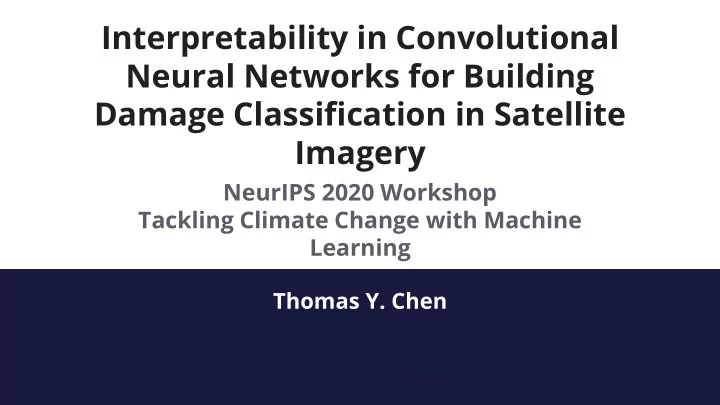

Interpretability in Convolutional Neural Networks for Building Damage Classification in Satellite Imagery NeurIPS 2020 Workshop Tackling Climate Change with Machine Learning Thomas Y. Chen
Computer Vision, Satellite Imagery, and Building Damage Assessment: An Introduction Natural Disasters ● 60,000 Deaths a Year ○ Immense infrastructure damage and economic loss ○ Increasing in frequency and intensity due to climate change ○ Satellite Imagery ● Quick and efficient, aids in the allocation of resources ○ Analyzed with deep learning based approaches to classify ○ building damage Lecture 1.1 Thomas Chen NeurIPS 2020: Tackling Climate Change with ML
Previous Works Image Classification ● Classical approaches, deep-learning techniques ○ Computer Vision for Satellite Imagery ● Marine ecology, weather forecasting, spread of disease ○ Agriculture, urban road damage ○ Change detection ○ Lecture 1.1 Thomas Chen NeurIPS 2020: Tackling Climate Change with ML
Previous Works Building Damage Assessment ● Semantic building segmentation ○ Cross-region transfer learning ○ Semi-supervised approaches ○ xBD: most comprehensive dataset ○ What do we contribute? ● Interpretability ○ Quantitative and Qualitative ■ Thomas Chen NeurIPS 2020: Tackling Climate Change with ML
Research Process Dataset analysis ● Develop a baseline model to classify building damage based on the ● post-disaster image only Develop improvements to the baseline model to classify building ● damage based on other aspects of the image, namely the pre-disaster image and the disaster type Compare the results ● Understand exactly what these networks are learning (leading to more ● interpretable models) Lecture 1.1 Thomas Chen NeurIPS 2020: Tackling Climate Change with ML
xBD Dataset Source: www.xview2.org Lecture 1.1 Thomas Chen NeurIPS 2020: Tackling Climate Change with ML
Preprocessing Creating building crops for per-building analysis, using labeled building • polygons provided Discarding small/unclear buildings • NeurIPS 2020: AI for Earth Sciences Other cleaning mechanisms • Train on equally distributed dataset (equal number of crops for each • category) Lecture 1.1 Thomas Chen NeurIPS 2020: Tackling Climate Change with ML
Baseline model ResNet18 (CNN architecture) - pre-trained on ImageNet data ● Cross-entropy loss ● Trained on 12,800 building crops ● Adam optimizer ● Learning rate of 0.001 ● 100 epochs ● NVIDIA Tesla K80 GPU ● Lecture 1.1 Thomas Chen NeurIPS 2020: Tackling Climate Change with ML
Baseline model ResNet18 (CNN architecture) - pre-trained on ImageNet data ● Cross-entropy loss ● Trained on 12,800 building crops ● Adam optimizer ● Learning rate of 0.001 ● 100 epochs ● NVIDIA Tesla K80 GPU ● Lecture 1.1 Thomas Chen NeurIPS 2020: Tackling Climate Change with ML
Baseline model ResNet18 (CNN architecture) - pre-trained on ImageNet data ● Cross-entropy loss ● Trained on 12,800 building crops ● Adam optimizer ● Learning rate of 0.001 ● 100 epochs ● NVIDIA Tesla K80 GPU ● Lecture 1.1 Thomas Chen NeurIPS 2020: Tackling Climate Change with ML
Improvements New types of input: pre-disaster image and disaster type ● Different loss functions: ● Ordinal Cross-entropy loss ○ Mean squared error ○ Other aspects remain the same ● Lecture 1.1 Thomas Chen NeurIPS 2020: Tackling Climate Change with ML
Results: Accuracy comparison Table 1. Comparison of accuracy on the validation set for nine different models. Unsurprisingly, the models trained on pre-disaster image, post-disaster image, and disaster type (all three modalities) performed the most accurately. Additionally, the models that utilized ordinal cross-entropy loss as their loss function achieved the best results. Lecture 1.1 Thomas Chen NeurIPS 2020: Tackling Climate Change with ML
Discussion Accuracy increases between three models: post-disaster image only, ● pre-and-post-disaster images, and pre-and-post disaster image plus disaster type Reasons for non-optimal accuracy ● Ordinal cross-entropy loss is the best criterion ● Contributes to the study of interpretability in deep learning models ● that classify building damage Lecture 1.1 Thomas Chen NeurIPS 2020: Tackling Climate Change with ML
Qualitative Interpretability Lecture 1.1 Thomas Chen NeurIPS 2020: Tackling Climate Change with ML
Conclusion We find that inputting different combinations of information does ● indeed improve model performance. Our study leads the way for more effective and efficient damage ● assessment in the event of a disaster. This can save lives and property. Climate change ● Lecture 1.1 Thomas Chen NeurIPS 2020: Tackling Climate Change with ML
Future Work There are more types of model input that should be investigated, ● building off of our work on interpretability Neighboring buildings ○ Different combination methods of the pre-disaster image and post- ● disaster image, as well as other methods Qualitative interpretability ● Cleaner dataset, more distinct differences between major damage ● and minor-damage, for instance. Lecture 1.1 Thomas Chen NeurIPS 2020: Tackling Climate Change with ML
Recommend
More recommend